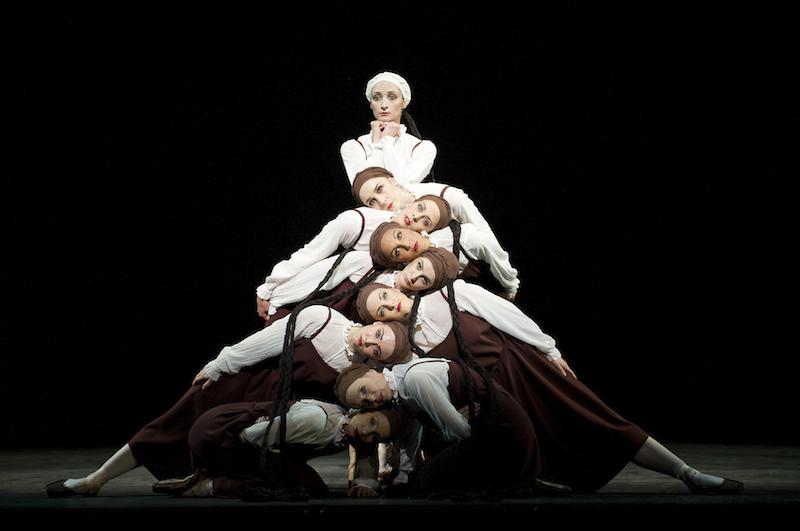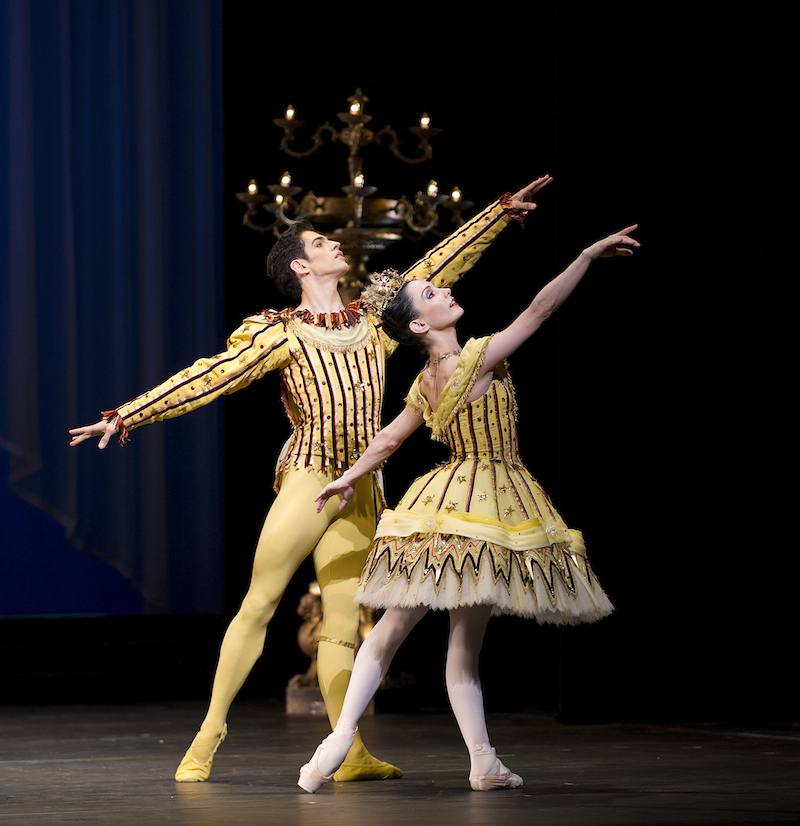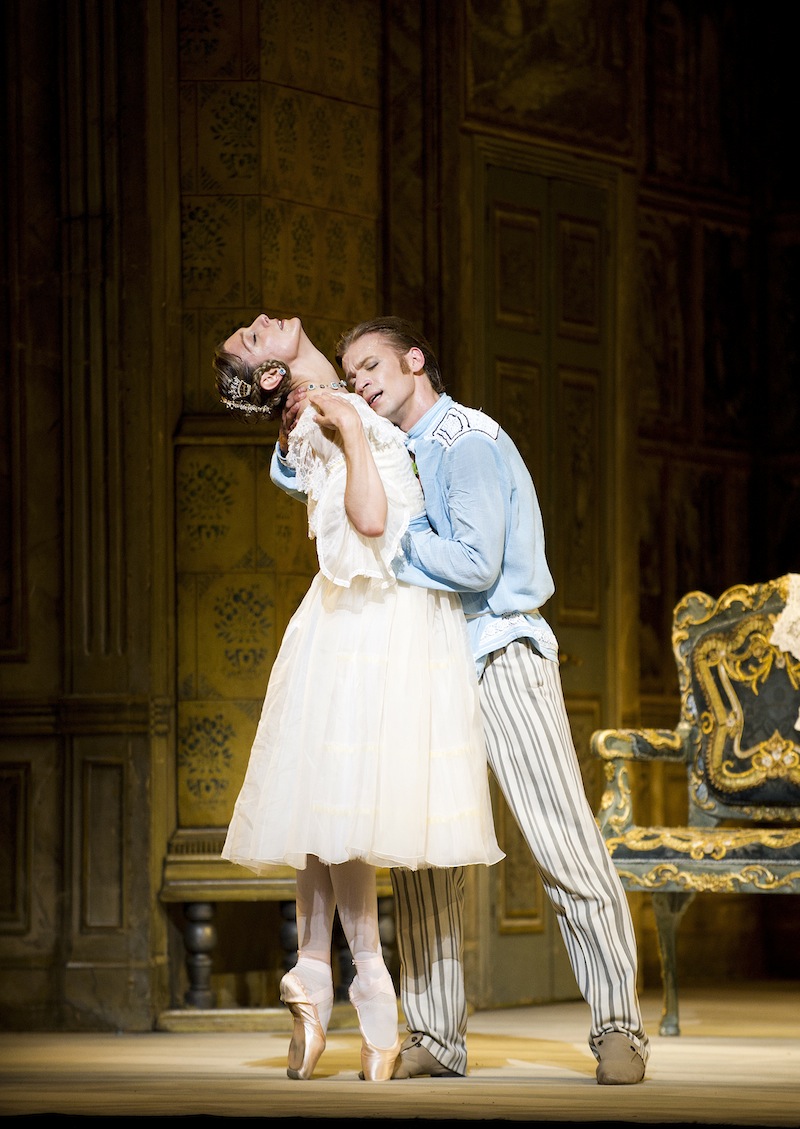Birthday Offering/ A Month in the Country/ Les Noces, Royal Ballet | reviews, news & interviews
Birthday Offering/ A Month in the Country/ Les Noces, Royal Ballet
Birthday Offering/ A Month in the Country/ Les Noces, Royal Ballet
Dame Monica Mason closes her 10-year directorship with a final choice of favourites

A birthday offering, a wedding celebration - with that, and one further creative collaboration ahead, Dame Monica Mason makes her farewell as director of the Royal Ballet after 10 years. The last programme of favourites from the store cupboard must always be a tricky one, but true to form the mistress of the great occasion (anniversaries have been a mainstay of her programming) picked rituals and ceremonies that stressed company ethos and values.
Those 10 years of her reign have been steady, stable, conservative - mostly restricted in programming to the box-office comfort zone; and while the fecundity of the Royal Ballet’s repertoire has attracted an awesome range of star dancers, essentially those stars have been firmly subsumed to the Mason company ethos - and if they didn’t like, as Sylvie Guillem didn’t, tough.
The line-up was not a blinding A-1 team of ballerinas consistently throughout
For her last triple bill Mason took for its themes Frederick Ashton, ballerinas, Russia and company cohesion: Ashton’s Birthday Offering (a traditional company pièce d’occasion), his heartbreaking chamber drama A Month in the Country, and the remarkable, still bewildering Ballets Russes work on which the Royal Ballet’s founder Ninette de Valois fed for inspiration: Bronislava Nijinska’s 1923 Les Noces, in which a peasant marriage is devastatingly arranged to a strange, vivid Stravinsky score.
Birthday Offering was created in 1956 to show off ballerinas to the new young Queen Elizabeth, and if one could have cast it from the stars who have illuminated Mason’s years, the seven ballerinas would have dazzled - from Guillem, Darcey Bussell, Leanne Benjamin and Miyako Yoshida to Tamara Rojo, Alina Cojocaru and Marianela Nuñez today. Most of them are not native to the Royal Ballet, which shows how powerfully its repertoire appealed worldwide. And that was another Mason storyline, the dominance of foreign dancers over native products.
 But there’ve been injuries and also Mason’s own dislike of flamboyance, and so the line-up was not a blinding A-1 team of ballerinas consistently throughout. With Rojo naturally centre, it called up sweet Yuhui Choe, crisp Laura Morera, courteous Sarah Lamb and dainty Roberta Marquez and a goodly selection of male cavaliers, but I wondered why Cojocaru and Nuñez weren’t in that A-team. We ought to gorge on ballerinas in Birthday Offering. And the second cast could be all the youngsters rising whom Mason puts her bets on.
But there’ve been injuries and also Mason’s own dislike of flamboyance, and so the line-up was not a blinding A-1 team of ballerinas consistently throughout. With Rojo naturally centre, it called up sweet Yuhui Choe, crisp Laura Morera, courteous Sarah Lamb and dainty Roberta Marquez and a goodly selection of male cavaliers, but I wondered why Cojocaru and Nuñez weren’t in that A-team. We ought to gorge on ballerinas in Birthday Offering. And the second cast could be all the youngsters rising whom Mason puts her bets on.
The style is powerfully studied of Petipa’s Sleeping Beauty, a lifelong source for Ashton - the ballerinas’ solos strongly suggest the fairies' variations, and the half-hour work proceeds like an Anglicised 19th-century grand pas, with soloists as beauteous heralds for a succulent pas de deux. Ashton is said to have done this one for a bet that he could make a pas de deux without a lift in it, as a riposte to the smash-hit acrobatic tendencies of the newly revealed Bolshoi Ballet, who had just made their debut in London. The spun-gauze result is the work of a genius, using the woman like tumbleweed, skimming the floor weightlessly on her toes, wafted along by the man with feathery sweeps of his arm. Rojo and Federico Bonelli (pictured right) make a satisfying classical couple, his gentlemanly correctness warmed by her intense presence.
Still, the dancers hadn't generally got under its skin, and the result was slightly stilted. I suppose it’s not a ballet one loves more than one appreciates it: it’s a grand ballet but not a great one, full of excellence but conscious of its dignity and not given good enough music to take flight from its vocabulary. The Glazunov arrangement has the feel of flamboyant costume jewellery, big golden tunes, scintillating bling, Russian flutes all a-flutter, the Hollywood feeling enhanced by the white drape behind.
 Whereas we all sincerely and deeply love A Month in the Country, a miraculous balletic rendering by Ashton in 1976 of a Turgenev short story about the turbulence in a fine household created by the arrival of a handsome young tutor. The young man echoes Don Giovanni in his opportunities for conquest (Mozart’s "La ci darem" from Don Giovanni is the theme for Chopin’s piano music). He has an easy one with the maid, an illicit one with the young daughter of the house, and then himself is knocked sideways by the passionate advances of the mother, who suddenly is ready to throw over everything she has in order to be in his arms.
Whereas we all sincerely and deeply love A Month in the Country, a miraculous balletic rendering by Ashton in 1976 of a Turgenev short story about the turbulence in a fine household created by the arrival of a handsome young tutor. The young man echoes Don Giovanni in his opportunities for conquest (Mozart’s "La ci darem" from Don Giovanni is the theme for Chopin’s piano music). He has an easy one with the maid, an illicit one with the young daughter of the house, and then himself is knocked sideways by the passionate advances of the mother, who suddenly is ready to throw over everything she has in order to be in his arms.
Fascinating, in psychology, in storytelling, in dance. The tall, gentle Zenaida Yanowsky and the tall, reticent Rupert Pennefather (pictured together) took the leading roles, and neither of them seized the ambivalent passions and risk of this drama by the throat (at least not if you have intrusive memories of Lynn Seymour or Natalia Makarova in the role of Natalia Petrovna. And I did wish for the originally scheduled tutor, the escapee Sergei Polunin.) More pointed playing came from the ever-impressive Emma Maguire as the daughter, Vera (she was a magnetic Effie in La Sylphide last month). Better playing would also have been welcome from the pit of the admittedly devilish piano part.
Month is terribly easy to get not quite right; Les Noces has a structure, visual language and tone so exact that it can hardly be got wrong, at least not at the Royal Ballet which is the work's adoptive parent. Over crackling pianos, voices chatter non-stop in Stravinsky’s music, about love, sex, marriage, the price of beer, the place of wives.
The girl being married is in the same convent-plain brown and white as everyone else, only her long symbolic braids differentiating her. No-one is interested in what she is thinking, and Nijinska somehow intuitively conjures a wail of sadness to rise unheard around the busy, exact formations, so extraordinarily modernist and unmistakably symbolic (she becomes the apex of a pyramid of submissive girls; the wedding party is a riot of public conformism). The work's boldness can't be dimmed, and despite its tight constraints there’s a place for individuals such as Ryoichi Hirano, the dignified groom, and Genesia Rosato, as the mother in her brief, plangent solo of anxiety for her daughter, to give you the human picture in a few seconds.
A careful and subdued programme, then, but only half the story of Mason’s directorship - the Titian creative event fielding the Royal Ballet’s in-house choreographers will tell the other half.
Watch the original cast of A Month in the Country, Lynn Seymour and Anthony Dowell, dance their wrenching pas de deux and face its aftermath
Watch Fonteyn and Nureyev rehearse Birthday Offeringwith Frederick Ashton in 1968
Buy
Explore topics
Share this article
Add comment
The future of Arts Journalism
You can stop theartsdesk.com closing!
We urgently need financing to survive. Our fundraising drive has thus far raised £49,000 but we need to reach £100,000 or we will be forced to close. Please contribute here: https://gofund.me/c3f6033d
And if you can forward this information to anyone who might assist, we’d be grateful.

Subscribe to theartsdesk.com
Thank you for continuing to read our work on theartsdesk.com. For unlimited access to every article in its entirety, including our archive of more than 15,000 pieces, we're asking for £5 per month or £40 per year. We feel it's a very good deal, and hope you do too.
To take a subscription now simply click here.
And if you're looking for that extra gift for a friend or family member, why not treat them to a theartsdesk.com gift subscription?
more Dance
 'We are bowled over!' Thank you for your messages of love and support
Much-appreciated words of commendation from readers and the cultural community
'We are bowled over!' Thank you for your messages of love and support
Much-appreciated words of commendation from readers and the cultural community
 R:Evolution, English National Ballet, Sadler's Wells review - a vibrant survey of ballet in four acts
ENB set the bar high with this mixed bill, but they meet its challenges thrillingly
R:Evolution, English National Ballet, Sadler's Wells review - a vibrant survey of ballet in four acts
ENB set the bar high with this mixed bill, but they meet its challenges thrillingly
 Like Water for Chocolate, Royal Ballet review - splendid dancing and sets, but there's too much plot
Christopher Wheeldon's version looks great but is too muddling to connect with fully
Like Water for Chocolate, Royal Ballet review - splendid dancing and sets, but there's too much plot
Christopher Wheeldon's version looks great but is too muddling to connect with fully
 iD-Reloaded, Cirque Éloize, Marlowe Theatre, Canterbury review - attitude, energy and invention
A riotous blend of urban dance music, hip hop and contemporary circus
iD-Reloaded, Cirque Éloize, Marlowe Theatre, Canterbury review - attitude, energy and invention
A riotous blend of urban dance music, hip hop and contemporary circus
 How to be a Dancer in 72,000 Easy Lessons, Teaċ Daṁsa review - a riveting account of a life in dance
Michael Keegan-Dolan's unique hybrid of physical theatre and comic monologue
How to be a Dancer in 72,000 Easy Lessons, Teaċ Daṁsa review - a riveting account of a life in dance
Michael Keegan-Dolan's unique hybrid of physical theatre and comic monologue
 A Single Man, Linbury Theatre review - an anatomy of melancholy, with breaks in the clouds
Ed Watson and Jonathan Goddard are extraordinary in Jonathan Watkins' dance theatre adaptation of Isherwood's novel
A Single Man, Linbury Theatre review - an anatomy of melancholy, with breaks in the clouds
Ed Watson and Jonathan Goddard are extraordinary in Jonathan Watkins' dance theatre adaptation of Isherwood's novel
 Peaky Blinders: The Redemption of Thomas Shelby, Rambert, Sadler's Wells review - exciting dancing, if you can see it
Six TV series reduced to 100 minutes' dance time doesn't quite compute
Peaky Blinders: The Redemption of Thomas Shelby, Rambert, Sadler's Wells review - exciting dancing, if you can see it
Six TV series reduced to 100 minutes' dance time doesn't quite compute
 Giselle, National Ballet of Japan review - return of a classic, refreshed and impeccably danced
First visit by Miyako Yoshida's company leaves you wanting more
Giselle, National Ballet of Japan review - return of a classic, refreshed and impeccably danced
First visit by Miyako Yoshida's company leaves you wanting more
 Quadrophenia, Sadler's Wells review - missed opportunity to give new stage life to a Who classic
The brilliant cast need a tighter score and a stronger narrative
Quadrophenia, Sadler's Wells review - missed opportunity to give new stage life to a Who classic
The brilliant cast need a tighter score and a stronger narrative
 The Midnight Bell, Sadler's Wells review - a first reprise for one of Matthew Bourne's most compelling shows to date
The after-hours lives of the sad and lonely are drawn with compassion, originality and skill
The Midnight Bell, Sadler's Wells review - a first reprise for one of Matthew Bourne's most compelling shows to date
The after-hours lives of the sad and lonely are drawn with compassion, originality and skill
 Ballet to Broadway: Wheeldon Works, Royal Ballet review - the impressive range and reach of Christopher Wheeldon's craft
The title says it: as dancemaker, as creative magnet, the man clearly works his socks off
Ballet to Broadway: Wheeldon Works, Royal Ballet review - the impressive range and reach of Christopher Wheeldon's craft
The title says it: as dancemaker, as creative magnet, the man clearly works his socks off
 The Forsythe Programme, English National Ballet review - brains, beauty and bravura
Once again the veteran choreographer and maverick William Forsythe raises ENB's game
The Forsythe Programme, English National Ballet review - brains, beauty and bravura
Once again the veteran choreographer and maverick William Forsythe raises ENB's game

Comments
Do not forget Sylvie
Yes, I almost put Guillem
Yes, I almost put Guillem into my Petrovna list, but not quite. She was just a tiny bit too rational and too in touch with her will; though exceptional in some of those tricky roles about feminine elusiveness (eg Marguerite and Manon). Alina Cojocaru could be superbly piteous in this run (and I mourn that Tamara Rojo may not get to do it).
Maybe this is what I love
If Mam'selle Guillem does
I suppose you are not a great
i thought both Ashton ballets